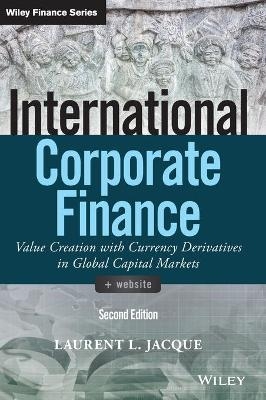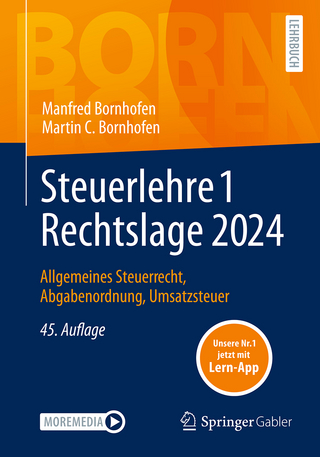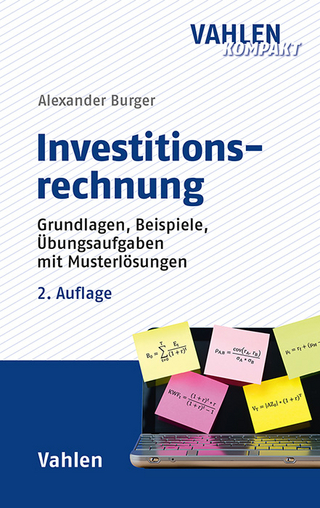
International Corporate Finance
John Wiley & Sons Inc (Verlag)
978-1-119-55046-4 (ISBN)
International Corporate Finance offers thorough coverage of the international monetary system, international financing, foreign exchange risk management and cross-border valuation. Additionally, the book offers keen insight on how disintermediation, deregulation and securitization are re-shaping global capital markets.
What is different about International Corporate Finance?
Each chapter opens with a real-life mini-case to anchor theoretical concepts to managerial situations.
Provides simple decision rules and “how to do” answers to key managerial issues.
Cross-border Mergers & Acquisitions, Project Finance, Islamic Finance, Asian Banking & Finance are completely new chapters that no other textbooks currently cover.
Accompanied with a comprehensive instructor support package which includes case studies, an Instructor’s Manual, PowerPoint slides, Multiple Choice Questions and more.
Laurent L. Jacque (Boston, MA) is the Walter B. Wriston Professor of International Finance & Banking at the Fletcher School of Law and Diplomacy (Tufts University) and Director of its International Business Studies Program. From 2004 to 2007 he was Fletcher’s Academic Dean and as such responsible for the design and the establishment of the new Master of International Business degree and the Center for Emerging Market Enterprises. Since 1990 he has also held a joint appointment at the HEC School of Management (France) as a Professor of Economics, Finance, and International Business.
Preface xvii
Acknowledgments xxv
About the Author xxvii
Chapter 1 What is International Corporate Finance? 1
The Uneven Reach of Globalization 2
The Rise of the Multinational Corporation 3
What is Different about International Corporate Finance? 6
Risks in the Wonderland of International Finance 8
Internationalization and the Locus of the Finance Function 12
The International Control Conundrum 15
Exploiting The Multinational Enterprise System 16
Summary 19
Questions for Discussion 19
References 20
Part One The International Monetary Environment 21
Chapter 2 Exchange Rates Regimes 23
Some First Principles about Exchange Rate Determination 24
World Map of Exchange Rate Regimes: The Flexibility × Convertibility Space 29
Floating Exchange Rates 31
Stabilized or Pegged Exchange Rates 39
Controlled Exchange Rates 46
To Float or to Fix: The Trilemma of International Finance 49
Summary 50
Questions for Discussion 51
Problems 52
Internet Exercises 54
References 54
Chapter 3 Yesterday and Yesteryear 57
Chronology of the International Monetary System 58
The Gold Standard (1878–1914, 1925–1931) 61
The Bretton Woods System (1944–1971) 63
Managed Floating Exchange Rates (1973–Present) 67
European Monetary System and the European Currency Unit (1979–1999) 68
Emerging Markets Currency Regimes and Crises 72
European Monetary Union and the Birth of the Euro (1999–Present) 76
Today and Tomorrow: The Current Map of Exchange Rates 84
Summary 86
Questions for Discussion 87
Problems 88
Internet Exercises 90
References 90
Case Study 3.1: Will the Eurozone Shutter? Plant Location and Exchange Rates for Hyundai 91
Chapter 4 The Balance of Payments 99
Fundamentals of Balance of International Payments Accounting 100
Current Account 105
Financial Account 107
Official Reserve Account 109
Statistical Discrepancies: Errors and Omissions 111
Balance of Payments and the Foreign Exchange Market 111
Debtor Versus Creditor Nations 115
Linking the Balance of Payments to National Income 118
Summary 119
Questions for Discussion 120
Problems 121
Internet Exercises 122
References 124
Case Study 4.1: When One of the BRIC(k)s Falls: Trials and Tribulations of the Indian Rupee 124
Part Two The Foreign Exchange Market and Currency Derivatives 129
Chapter 5 The Foreign Exchange Market 131
How Forex is Traded: The Institutional Framework 132
Foreign Exchange Products 140
Exchange Rate Quotations 142
Summary 155
Questions for Discussion 156
Problems 157
Internet Exercises 160
References 160
Case Study 5.1: Banco Mercantil Internacional’s Forex Losses 160
Chapter 6 Interest Rate Arbitrage and Parity 165
Interest Rate Arbitrage Theorem 166
Interest Rate Parity 174
Uncovered Interest Rate Arbitrage and the Carry Trade 181
Summary 184
Appendix 6A: Transaction Costs: Interest Rate Arbitarge with Bid-Ask Spreads (Advanced) 185
Appendix 6B: Interest Rate Parity and Asymmetric Taxation 187
Questions for Discussion 188
Problems 188
Internet Exercises 195
References 195
Case Study 6.1: Brazil Rede Globo’s Short-Term Funding 195
Chapter 7 Purchasing Power Parity and the International Parities Framework 199
Purchasing Power Parity 200
The Linkages Between Interest, Inflation, and Exchange Rates 213
Questions for Discussion 220
Problems 220
Internet Exercises 221
References 222
Chapter 8 Currency Futures and Options 223
A Brief History of Derivatives 223
Currency Futures 228
Currency Options 234
Risk Profile of Currency Options 236
Option Strategies 239
Put-Call Parity Theorem 245
The Valuation of Currency Options 248
Derivatives and Zero-Premium Options 254
Summary 258
Appendix 8A: Pricing Currency Options 259
Questions for Discussion 261
Problems 261
Internet Exercises 264
References 264
Case Study 8.1: Daewoo’s Unorthodox Funding Strategy 264
Part Three International Financing 269
Chapter 9 The International Financial Sector and the Dynamics of Global Capital Markets 271
Financing as a Global Procurement Decision 272
The Financial System and Financial (Dis)Intermediation 273
Securitization and the (Lower) Cost of Consumer Financing 281
Deregulation 287
Mapping the Financial System/Capital Market Emergence Process 290
Summary 297
Questions for Discussion 298
Problems 298
Internet Exercises 300
References 300
Case Study 9.1: How Thai Airways FOILs Jet Fuel Price Risk 301
Chapter 10 Sourcing Equity Globally 307
A Grand Tour of Equity Markets 308
Global Equity Financing as a Procurement Decision 317
Internationalizing the Cost of Capital: The Landmark Case of Novo Industri 318
Why do Firms Cross-List? 323
How to Source Equity Globally 325
Summary 331
Questions for Discussion 332
Problems 333
Internet Exercises 334
References 335
Case Study 10.1: Jazztel’s Foreign IPO 335
Chapter 11 Sourcing Debt from Global Bond Markets 345
The International Debt Procurement Decision 346
Grand Tour of the Global Debt Market 347
Cost of Foreign Currency Debt Financing 356
Debt Refinancing 361
The International Debt Financing Conundrum 364
Summary 366
Questions for Discussion 366
Problems 367
Internet Exercises 372
References 372
Case Study 11.1: McDonald’s Dim Sum Bonds: “Lovin’ It” 372
Chapter 12 Currency, Interest Rate, and Credit Default Swaps 377
Currency Swaps 378
Interest Rate Swaps 383
Credit Default Swaps 391
Summary 397
Questions for Discussion 397
Problems 398
Internet Exercises 400
References 400
Case Study 12.1: The Demise of AIG 400
Chapter 13 International Trade Financing 405
A Brief History of International Trade 406
The Trilogy of Risks in Exporting 407
Managing Credit Risk 409
Managing Currency Risk 410
Managing Country Risk 411
The Mechanics of Trade Financing with a Letter of Credit 412
Financing Exports 415
Pre-Export Financing 418
Government-Sponsored Export Credit Agencies 422
Summary 423
Questions for Discussion 424
Problems 424
Internet Exercises 426
Case Study 13.1: Warrick Pharmaceuticals Inc. 426
Part Four Managing Foreign Exchange Risk 431
Chapter 14 The Case for Foreign Exchange Risk Management 433
Defining Foreign Exchange Risk Management and its Objectives 435
Can Hedging Currency Risk Increase the Value of the Firm? 437
When is Hedging Currency Risk Irrelevant? 440
From Hedging to Managing Currency Risk 441
The Building Blocks of Foreign Exchange Risk Management 443
Summary 445
Appendix 14A: Foreign Exchange Risk Management: What do Firms do? 446
Questions for Discussion 446
References 447
Case Study 14.1: Bio-Oils Energy S.L. 447
Chapter 15 Forecasting Exchange Rates 455
Market-Based Forecasts 456
Model-Based Forecasts: Technical Versus Econometric Modeling Approaches 461
Composite Forecasts 468
How to Use Currency Forecasts 469
Summary 470
Appendix 15A: Forecasting Pegged Yet Adjustable Exchange Rates 470
Questions for Discussion 476
Problems 477
Internet Exercises 479
References 479
Case Study 15.1: Euclides Engineering, Ltd. 480
Chapter 16 Managing Transaction Exposure 483
Measuring Transaction Exposure 484
The Mechanics of Hedging Transaction Exposure 488
Hedging and Financing International Trade 500
Eliminating Foreign Exchange Rate Risk in Long-Term Contracts 501
Exchange Rate Risk in International Bidding 508
How Much to Hedge Transaction Exposure 512
Summary 513
Questions for Discussion 514
Problems 514
References 520
Case Study 16.1: Hedging Currency Risk at TT Textiles 521
Chapter 17 Managing Translation Exposure 531
What is Translation Exposure? 531
Should Translation Exposure be Hedged? 532
Alternative Translation Methods 533
The Mechanics of Contractual Hedging 539
The Mechanics of Financial Hedging 546
Summary 550
Appendix 17A: Accounting Valuation and the Concept of Translation Exposure 551
Questions for Discussion 555
Problems 555
Internet Exercises 560
References 560
Case Study 17.1: Wilkinson Sword’s Trials and Tribulations in Turkey 560
Chapter 18 Managing Economic Exposure 567
A Taxonomy of Economic Exposures 568
Toward an Operational Measure of Economic Exposure 575
Managing Operating Exposure 578
Summary 583
Questions for Discussion 584
Problems 584
References 587
Case Study 18.1: Peugeot Citroën SA’s Economic Exposure to the South Korean Won 588
Part Five Cross-Border Valuation and Foreign Investment Analysis 591
Chapter 19 Foreign Market Entry Strategies and Country Risk Management 593
Contractual Modes of Foreign Market Entry 594
Foreign Market Entry Through Foreign Direct Investments 599
Country Risk 600
Costs/Benefits of Foreign Direct Investment to Host Countries 608
Summary 612
Questions for Discussion 613
Internet Exercises 613
References 614
Case Study 19.1: Carrefour’s Indian Entry Strategy 614
Chapter 20 International Capital Budgeting 619
The Foreign Direct Investment Decision-Making Process 619
A Primer on Evaluating Investment Opportunities 622
What is Different About Evaluating Foreign Investment Proposals? 624
Case Study: Renault Invests in India 629
Global Cost of Equity Capital 639
Optimal Worldwide Capital Structure 643
Summary 644
Appendix 20A: Adjusted Present Value 645
Appendix 20B: Real Options 648
Questions for Discussion 656
Problems 656
Internet Exercises 660
References 660
Chapter 21 Cross-Border Mergers and Acquisitions 661
A Brief History of Mergers and Acquisitions 662
The Industrial Logic of Mergers and Acquisitions 662
Are Cross-Border Acquisitions Different? 664
Valuation of Foreign Acquisitions 671
Ciments Lafarge Enters Vietnam 673
Summary 680
Questions for Discussion 681
Problems 681
Internet Exercises 683
Case Study 21.1: Etihad’s Proposed Acquisition of Malaysia Airlines 684
Chapter 22 Project Finance 689
What is Project Finance? 690
Anatomy of Project Finance: The Case of the Ras Laffan Liquefied Natural Gas Company 696
Valuing Project Finance: The Esty Model 696
Summary 704
Questions for Discussion 705
References 705
Case Study 22.1: Clean Infra Ltd Project Finance 706
Chapter 23 Global Investing 713
The Basics of International Portfolio Management 714
The Gains from International Diversification 722
Trials and Tribulations in Foreign Equity Investing 729
Currency Risk in Global Investing 730
Alternative Modes of Investing in Foreign Equity 733
The New Landscape of Global Investing 734
Summary 741
Appendix 23A: In Search of Alpha at Global Thematic Partner is found on the Book Website at www.wiley.com/go/intlcorpfinance2e 741
Questions for Discussion 742
Problems 742
Internet Exercises 744
References 744
Part Six Managing the Multinational Financial System 747
Chapter 24 Managing the Multinational Financial System 749
A Primer on International Taxation 749
The Multinational Financial System 753
Exploiting the System’s Potential to Minimize Global Tax Liabilities 755
Designing a Global Dividends Remittance Strategy 761
Centralizing Cash Management 765
Summary 774
Questions for Discussion 775
Problems 775
Internet Exercises 777
References 777
Appendix: Answers to Selected Problems 779
About the Companion Website 787
Index 789
Continued on the Website
Chapter 25 International Control Conundrum (extension of Part 6) 805
A Primer on Managerial Control 806
The International Control Conundrum 809
EVA-Based Contingent Budgeting and Performance Assessment 815
Summary 821
Appendix 25A: Applying The EVA-Based Control System 822
Questions for Discussion 826
References 826
Chapter 26 Asian Finance and Banking (extension of Part 3) 827
Asian Finance: Common Historical Roots, Diverse Paths 828
Adaptive Responses: Crises and Institutional Change in Asian Finance 832
Business Organization, Corporate Ownership, and Governance 836
Corporate Governance 841
Capital Market Development 846
Capital Structure and the Cost of Capital 855
Performance, Value, and the Practice of Corporate Finance 857
Summary 860
Questions for Discussion 860
References 861
Chapter 27 Islamic Banking and Finance (extension of Part 3) 863
The Underlying Principles of Islamic Finance 864
The Evolution of Islamic Finance 868
Islamic Financing Products 872
Shariah-Compliant Asset Management 879
Islamic Banking 880
Islamic Finance and the Global Financial Meltdown 885
Summary 886
Questions for Discussion 888
References 888
Case Study 27.1: When Emirates Airline Taps Islamic Finance 888
Appendix 23A to Chapter 23: In Search of Alpha at Global Thematics Partners (GTP) 894
Glossary 899
| Erscheinungsdatum | 02.11.2019 |
|---|---|
| Reihe/Serie | Wiley Finance |
| Verlagsort | New York |
| Sprache | englisch |
| Maße | 185 x 259 mm |
| Gewicht | 1860 g |
| Themenwelt | Wirtschaft ► Betriebswirtschaft / Management ► Finanzierung |
| Wirtschaft ► Betriebswirtschaft / Management ► Unternehmensführung / Management | |
| ISBN-10 | 1-119-55046-7 / 1119550467 |
| ISBN-13 | 978-1-119-55046-4 / 9781119550464 |
| Zustand | Neuware |
| Haben Sie eine Frage zum Produkt? |
aus dem Bereich


